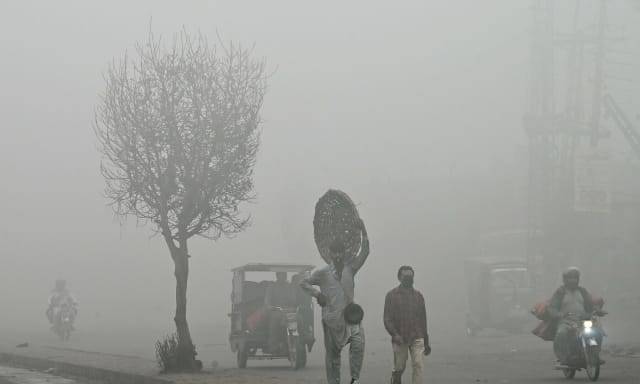Main Points In Hindi (मुख्य बातें – हिंदी में)
-
खतरनाक वायु गुणवत्ता: पाकिस्तान और उत्तरी भारत, विशेषकर पंजाब, में प्रदूषण के स्तर बेहद खतरनाक हो गए हैं, जहां वायु गुणवत्ता सूचकांक 1,000 से अधिक है, जो सामान्य सीमाओं से काफी ऊपर है। PM2.5 कणों की सांद्रता विश्व स्वास्थ्य संगठन की अनुशंसित सीमा से 110 गुना अधिक हो गई है।
-
स्वास्थ्य समस्याएं: इस प्रदूषण के कारण उपचार की आवश्यकता वाले मरीजों की संख्या में बढ़ोतरी हुई है, और 30,000 से अधिक लोगों को स्मॉग से संबंधित बीमारियों का इलाज किया गया है। अस्पताल में सांस संबंधी समस्याओं से पीड़ित लोग भर गए हैं।
-
सरकारी उपाय: सरकार ने प्रदूषण के गंभीर स्तर को देखते हुए स्कूलों, सरकारी कार्यालयों, और कई सार्वजनिक स्थानों को बंद करने के साथ-साथ अन्य नए प्रतिबंध लगा दिए हैं। इन उपायों का उद्देश्य सार्वजनिक स्वास्थ्य की रक्षा करना है।
-
बच्चों की सुरक्षा: बच्चे इस प्रदूषण का विशेष रूप से अधिक शिकार हैं, क्योंकि उनकी प्रतिरक्षा प्रणाली विकासशील होती है। विशेषज्ञों ने चेतावनी दी है कि खराब वायु गुणवत्ता न केवल बच्चों की शिक्षा को प्रभावित कर रही है, बल्कि उनके जीवन के लिए भी खतरनाक स्थितियाँ उत्पन्न कर रही हैं।
- पर्यावरणीय सहयोग की आवश्यकता: क्षेत्रीय अधिकारियों द्वारा वायु प्रदूषण से निपटने के लिए भारतीय सरकार से बातचीत की जा रही है। "जलवायु कूटनीति" की आवश्यकता के बारे में चर्चा की गई है, जिसे बढ़ती पर्यावरणीय चुनौतियों से निपटने के लिए जरूरी बताया गया है।
Main Points In English(मुख्य बातें – अंग्रेज़ी में)
Here are the main points summarized from the provided text:
-
Severe Air Pollution Crisis: Satellite images reveal dangerously high levels of toxic smog blanketing Pakistan and northern India, particularly affecting the Punjab province and the capital, New Delhi. This unprecedented pollution has led to the closure of schools and public places, raising health concerns for millions.
-
Contributing Factors: The seasonal air pollution crisis worsens during winter due to a combination of factors, including agricultural burning, coal-powered plants, traffic emissions, and stagnant weather conditions. Cold, dry air traps pollutants, exacerbating the decline in air quality.
-
Health Impacts: Recently, parts of Punjab have reported alarming Air Quality Index levels exceeding 1,000, significantly above the hazardous threshold of 300. The concentration of PM2.5, a harmful particle, has surged to 110 times the recommended limit by the World Health Organization, leading to respiratory issues and other serious health problems, particularly in children.
-
Government Response: In response to the health crisis, the government has implemented several measures, including closing schools, government offices, parks, and public venues in affected areas. New restrictions have been placed on outdoor activities and business hours for non-essential establishments.
- Call for Action and Regional Cooperation: Experts emphasize the need for immediate government action to address pollution and safeguard children’s health in the region. Officials are urging for dialogues with the Indian government about collaborative efforts to tackle air pollution as a shared concern.


Complete News In Hindi(पूरी खबर – हिंदी में)
सैटेलाइट तस्वीरें खतरनाक स्तर का खुलासा करती हैं विषाक्त पूर्वी क्षेत्र में धुंध की चादर बिछी हुई है पाकिस्तान और उत्तरी भारतचारों ओर फैली घनी धुंध के साथ पंजाब प्रांत में पाकिस्तान और में विस्तार भारतराजधानी नई दिल्ली समेत। प्रदूषण के इन अभूतपूर्व स्तरों ने स्कूलों और सार्वजनिक स्थानों को बंद करने के लिए प्रेरित किया है पाकिस्तानजैसे-जैसे लाखों लोगों की स्वास्थ्य संबंधी चिंताएँ बढ़ती जा रही हैं।
यह मौसमी वायु प्रदूषण संकट आम तौर पर सर्दियों के महीनों के दौरान खराब हो जाता है, जब कारकों का एक संयोजन – जैसे कि कृषि जलाना, कोयले से चलने वाले बिजली संयंत्र, यातायात उत्सर्जन, और स्थिर, हवा रहित स्थितियां – एक मोटी पीली धुंध में योगदान करती हैं। ठंडी और शुष्क हवा प्रदूषण को फँसा लेती है, इसे गर्म परिस्थितियों की तरह फैलने से रोकती है, जिससे हवा की गुणवत्ता में और गिरावट आती है।
पिछले सप्ताह के दौरान, के कुछ भाग पंजाब127 मिलियन से अधिक लोगों के घर, में वायु गुणवत्ता सूचकांक का स्तर 1,000 से अधिक हो गया है, जो 300 की खतरनाक सीमा से कहीं अधिक है। मुल्तान शहर में, सबसे छोटे और सबसे खतरनाक वायु प्रदूषक PM2.5 की सांद्रता, इससे भी अधिक स्तर पर पहुंच गई है। विश्व स्वास्थ्य संगठन की अनुशंसित सीमा से 110 गुना। जब साँस ली जाती है, तो PM2.5 कण फेफड़ों में गहराई तक प्रवेश करते हैं और रक्तप्रवाह में प्रवेश कर सकते हैं, जिससे बच्चों में श्वसन संबंधी बीमारियाँ, हृदय की स्थिति, कैंसर और संज्ञानात्मक हानि जैसी गंभीर स्वास्थ्य समस्याएं पैदा हो सकती हैं।
प्रभावित इलाकों के अस्पताल सांस संबंधी समस्याओं से पीड़ित मरीजों से भर गए हैं। पंजाबस्वास्थ्य विभाग ने बताया कि स्मॉग से संबंधित बीमारियों के लिए 30,000 से अधिक लोगों का इलाज किया गया है। स्वास्थ्य अधिकारियों ने फेफड़ों की बीमारियों, एलर्जी और आंखों और गले में जलन के मामलों में “अभूतपूर्व वृद्धि” देखी है, खासकर फैसलाबाद, मुल्तान और गुजरांवाला जैसे शहरों में, जहां हवा की गुणवत्ता खतरनाक रूप से कम है।
जवाब में, सरकार ने सार्वजनिक स्वास्थ्य की रक्षा के लिए कई उपाय लागू किए हैं। स्कूल और सरकारी कार्यालय 17 नवंबर तक बंद कर दिए गए, और 18 जिलों के सभी पार्क, खेल के मैदान, संग्रहालय, चिड़ियाघर और ऐतिहासिक स्थल दस दिनों के लिए बंद कर दिए गए। खेल, त्योहारों और आउटडोर रेस्तरां में भोजन जैसी बाहरी गतिविधियों पर प्रतिबंध सहित नए प्रतिबंध लाहौर सहित चार जिलों तक बढ़ा दिए गए हैं। फार्मेसियों और गैस स्टेशनों जैसे आवश्यक व्यवसायों को छोड़कर, बाजार और मॉल रात 8 बजे तक बंद हो जाने चाहिए।
बच्चे विशेष रूप से असुरक्षित हैं, क्योंकि उनकी विकासशील प्रतिरक्षा प्रणाली उन्हें प्रदूषित हवा के प्रभावों के प्रति अधिक संवेदनशील बनाती है। खुरम गोंडल, सेव द चिल्ड्रन से पाकिस्तानने चेतावनी दी कि खराब वायु गुणवत्ता और बढ़ते तापमान के कारण न केवल बच्चों की शिक्षा बाधित होती है, बल्कि उन्हें जीवन-घातक स्थितियों का भी सामना करना पड़ता है। उन्होंने प्रदूषण से निपटने और बार-बार आने वाली समस्या का दीर्घकालिक समाधान खोजने के लिए तत्काल सरकारी कार्रवाई का आह्वान किया।
पर्यावरण संकट ने क्षेत्रीय सहयोग पर भी चर्चा को प्रेरित किया है। अधिकारी अंदर पंजाब एक साझा चिंता के रूप में वायु प्रदूषण से निपटने पर बातचीत का आग्रह करते हुए, भारत सरकार से संपर्क किया है। राजा जहांगीर अनवर, पर्यावरण और जलवायु परिवर्तन सचिव पंजाबबढ़ती पर्यावरणीय चुनौतियों से निपटने के लिए “जलवायु कूटनीति” की आवश्यकता पर बल दिया।
एक हालिया अध्ययन के अनुसार, विश्व स्तर पर वायु प्रदूषण एक महत्वपूर्ण स्वास्थ्य खतरा बना हुआ है, जो अकेले जीवाश्म ईंधन से संबंधित प्रदूषण से सालाना 5.1 मिलियन मौतों के लिए जिम्मेदार है। विश्व स्वास्थ्य संगठन की रिपोर्ट है कि परिवेश और घरेलू वायु प्रदूषण के संयुक्त प्रभाव से हर साल 6.7 मिलियन मौतें होती हैं। जैसे-जैसे जलवायु परिवर्तन तीव्र होता जा रहा है, वैज्ञानिकों ने चेतावनी दी है कि प्रदूषण और बदतर होगा, अत्यधिक गर्मी और बदले हुए मौसम के पैटर्न से हानिकारक प्रदूषकों का प्रसार बढ़ जाएगा। इस साल की शुरुआत में एक रिपोर्ट में जीवाश्म ईंधन की रिकॉर्ड खपत का खुलासा हुआ, जिसने कार्बन प्रदूषण को अभूतपूर्व स्तर तक पहुंचा दिया है।
Complete News In English(पूरी खबर – अंग्रेज़ी में)
Satellite images reveal dangerously high levels of toxic smog covering the eastern regions of Pakistan and northern India, particularly thick fog is evident in Punjab province across Pakistan and reaching the capital of India, New Delhi. These unprecedented pollution levels have led to the closure of schools and public spaces in Pakistan as health concerns for millions continue to rise.
This seasonal air pollution crisis typically worsens during the winter months, due to a combination of factors such as agricultural burning, coal-fired power plants, traffic emissions, and stagnant, windless conditions that contribute to a thick yellow fog. Cold and dry air traps the pollution, preventing it from dispersing like it would in warmer conditions, leading to further deterioration in air quality.
Over the past week, certain areas in Punjab, home to over 127 million people, recorded air quality index levels exceeding 1,000, far above the hazardous threshold of 300. In the city of Multan, the concentration of the most dangerous air pollutant, PM2.5, has even reached levels 110 times higher than the World Health Organization’s recommended limit. When inhaled, PM2.5 particles can penetrate deep into the lungs and enter the bloodstream, potentially causing severe health issues such as respiratory diseases, heart conditions, cancer, and cognitive impairments in children.
Hospitals in the affected areas are overflowing with patients suffering from respiratory problems. The Punjab health department has reported that more than 30,000 people have been treated for smog-related illnesses. Health officials have noted an “unprecedented increase” in cases of lung diseases, allergies, and irritation of the eyes and throat, especially in cities like Faisalabad, Multan, and Gujranwala, where air quality is alarmingly poor.
In response, the government has implemented several measures to protect public health. Schools and government offices are closed until November 17, and all parks, playgrounds, museums, zoos, and historical sites in 18 districts have been shut down for ten days. New restrictions have also been extended to four districts, limiting outdoor activities such as sports, festivals, and dining at outdoor restaurants. Markets and malls must close by 8 PM, except for essential businesses like pharmacies and gas stations.
Children are particularly vulnerable, as their developing immune systems make them more sensitive to the effects of polluted air. Khuram Gondal from Save the Children in Pakistan warned that poor air quality and rising temperatures not only disrupt children’s education but also expose them to life-threatening conditions. He called for immediate government action to combat pollution and find long-term solutions to this recurring issue.
This environmental crisis has also sparked discussions about regional cooperation. Officials in Punjab have reached out to the Indian government, urging discussions on addressing air pollution as a shared concern. Raja Jahangir Anwar, the Secretary for Environment and Climate Change in Punjab, emphasized the need for “climate diplomacy” to tackle escalating environmental challenges.
According to a recent study, air pollution continues to pose a significant health threat globally, accounting for 5.1 million deaths annually attributed to fossil fuel-related pollutants. The World Health Organization reports that the combined effects of outdoor and household air pollution result in 6.7 million deaths each year. As climate change intensifies, scientists warn that pollution may worsen, with harmful pollutants spreading due to increasing heat and altered weather patterns. A report earlier this year revealed record fossil fuel consumption, pushing carbon pollution to unprecedented levels.




